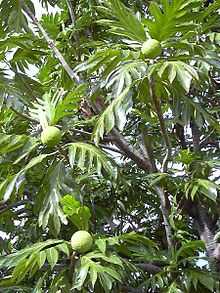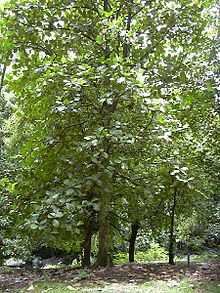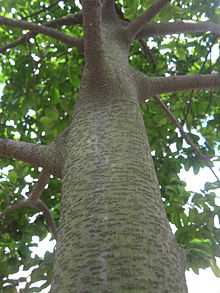Artocarpus
| Artocarpus | |
|---|---|
 | |
| Breadfruit (Artocarpus altilis) | |
| Scientific classification | |
| Kingdom: | Plantae |
| (unranked): | Angiosperms |
| (unranked): | Eudicots |
| (unranked): | Rosids |
| Order: | Rosales |
| Family: | Moraceae |
| Tribe: | Artocarpeae[1] |
| Genus: | Artocarpus J.R.Forster & G.Forster |
| Species | |
|
| |
Artocarpus is a genus of approximately 60 trees and shrubs of Southeast Asian and Pacific origin, belonging to the mulberry family, Moraceae.
Description
All Artocarpus species are laticiferous trees or shrubs that are composed of leaves, twigs and stems capable of producing a milky sap. The fauna type is monoecious and produces unisexual flowers; furthermore, both sexes are present within the same plant. The plants produce small, greenish, female flowers that grow on short, fleshy spikes. Following pollination, the flowers grow into a syncarpous fruit, and these are capable of growing into very large sizes. The stipulated leaves vary from small and entire (Artocarpus integer) to large and lobed (Artocarpus altilis), with the cordate leaves of the species A. altilis ending in long, sharp tips.
Taxonomy
The name Artocarpus is derived from the Greek words artos ("bread") and karpos ("fruit"). This name was coined by Johann Reinhold Forster and J. Georg Adam Forster, a father-and-son team of botanists aboard the HMS Resolution on James Cook's second voyage. It is maintained as a conserved name.
In the most recent revision of Artocarpus, the highly variable species A. communis is a complex of three species of breadfruit: A. altilis, A. mariannensis, and A. camansi.
Distribution
Most species of Artocarpus are restricted to Southeast Asia; a few cultivated species are more widely distributed, especially A. altilis and A. heterophyllus, which are cultivated throughout the tropics.[2]
Uses
Several species in the genus bear edible fruit and are commonly cultivated: breadfruit (Artocarpus altilis), cempedak (Artocarpus integer), jackfruit (Artocarpus heterophyllus), kwai muk (Artocarpus hypargyreus), lakoocha (Artocarpus lakoocha), pudau (Artocarpus kemando), anjily (Artocarpus hirsutus), chaplaish (Artocarpus chama), and marang (Artocarpus odoratissimus).
Breadfruit and jackfruit are cultivated widely in the tropical Southeast Asia. Other species are cultivated locally for their timber, fruit or edible seeds. Anjily, A. hirsutus, is grown for fruit and timber in the Western Ghats.
Subgenera
Recent phylogenetic research, based on leaf arrangement, leaf anatomical characters and stipules, indicates that there are at least two subgenera in Artocarpus:
- Subgenus Artocarpus: Perianth of fruit is partially connate.
- Subgenus Pseudojaca: Perianth is entirely connate.
Subgenus Pseudojaca is allied to the genus Prainea, and some researchers treat this taxon as a third subgenus of Artocarpus.

Selected species

- A. altilis (Parkinson) Fosberg - Breadfruit, Seeded Breadfruit, Antipolo, Camansi, Anubing
- A. anisophyllus Miq. - Entawak
- A. blancoi (Elmer) Merr.
- A. camansi Blanco
- A. chama Buch.-Ham. - Chaplaish
- A. dadah Miq.
- A. elasticus Reinw. ex Blume - Bendo, Terap
- A. gomezianus Wall. ex Trécul
- A. heterophyllus Lam. - Nangka, Jackfruit
- A. hirsutus Lam. - Angily, Angelin, Hirsute Artocarpus, Aini Maram, Aini
- A. hypargyreus Hance ex Benth. - Kwai Muk
- A. integer (Thunb.) Merr. - Cempedak
- A. kemando Miq. - Pudau
- A. lacucha Buch.-Ham. - Lakoocha, monkey fruit
- A. lignanensis Merr.
- A. mariannensis Trécul
- A. nitidus Trécul - Butong
- A. nobilis Thwaites
- A. odoratissimus Blanco - Marang
- A. ovatus Blanco
- A. rigidus Blume - Monkey Jackruit
- A. rubrovenus Warb.
- A. sarawakensis F.M.Jarrett - Pingan
- A. scortechinii King - Two Winged Artocarpus
- A. sericicarpus F.M.Jarrett - Pedalai
- A. tamaran Becc. - Elephant jack
- A. tonkinensis A.Chev. ex Gagnep.
- A. treculianus Elmer - African breadfruit[3][4][5]
Notes
- ↑ "Artocarpus J. R. Forst. & G. Forst.". Germplasm Resources Information Network. United States Department of Agriculture. 2009-01-16. Retrieved 2009-03-11.
- ↑ Zerega, Nyree J. C.; Diane Ragone; Timothy J. Motley (2005). "Systematics and Species Limits of Breadfruit (Artocarpus, Moraceae)". Systematic Botany 30 (3): 603–15. doi:10.1600/03636440yy54782134.
- ↑ GRIN. "Species in GRIN for genus Artocarpus". Taxonomy for Plants. National Germplasm Resources Laboratory, Beltsville, Maryland: USDA, ARS, National Genetic Resources Program. Retrieved April 6, 2010.
- ↑ "Name - Artocarpus J.R.Forst. & G.Forst. subordinate taxa". Tropicos. Saint Louis, Missouri: Missouri Botanical Garden. Retrieved April 6, 2010.
- ↑ "Query Results for Genus Genus". IPNI. Retrieved April 6, 2010.
References
- Zerega, N. J. C. and T. J. Motley. 2001. Artocarpus (Moraceae) molecular phylogeny and the systematics and origins of breadfruit, Artocarpus altilis. Botanical Society of America Annual Meeting. Albuquerque, NM. August 12–16, 2001.
| Wikimedia Commons has media related to Artocarpus. |
| Wikispecies has information related to: Artocarpus |